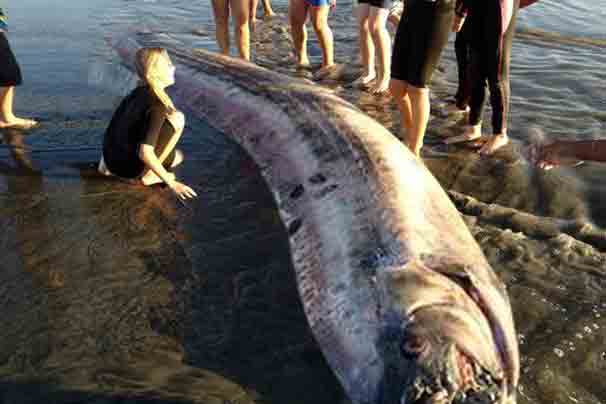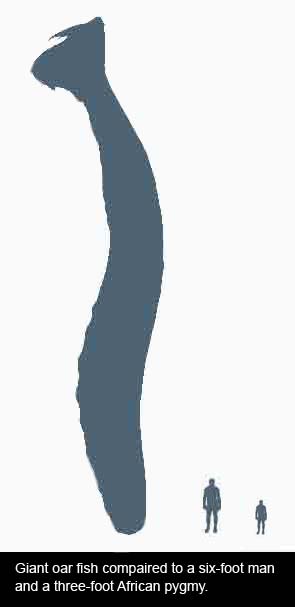Giant Oar Fish Linked To Fukushima Disaster Found In California; Coast Guard Issues Alert
Giant Oarfish Discovered Off California Coast And Scientists Suspect Radioactive Gigantism
Published October 19, 2013
By BUTCH WITT

Nearly two years after a powerful earthquake triggered a leak at Japan's Fukushima Dai-ichi Nuclear Plant, the effects of that disaster finally reached the other side of the planet – and in a big way.
On Friday, people strolling on the beach in Santa Monica discovered what might be the largest modern fish ever to roam the seas washed up on the shore. Dubbed “Godzilla Fish” by the media, the 95-foot colossus started its life as a rare oarfish. Scientists believe that following the 2011 disaster at the Fukushima Dai-ichi Nuclear Power Plant in the Futaba District of Japan, the oarfish suffered genetic mutations that triggered uncontrolled growth – or “radioactive gigantism.”
Sometimes science fiction borrows from reality, and now we are seeing 1960s science fiction come to life.”
For perspective on how unusual the historic find is, the previous largest oarfish ever discovered was only 19-feet long.
“We are confident that this fish comes from the Fukushima Dai-ichi region,” said Susan Cleary-Kohen of the National Oceanic and Atmospheric Administration. “We can tell from the radioactive Cesium present in its tissue. We also have strong cause to believe that the nuclear event in Japan triggered radioactive gigantism in this particular specimen,” she said.
The discovery of the so-called Godzilla fish follows the finding of unusually large starfish, shrimp and other sea life in both Hawaii and Guam. Scientists suspected a relationship to the Fukushima disaster, but were unsure. Now there seems no doubt after the detection of radioactive Cesium.
 “Sometimes science fiction borrows from reality, and now we are seeing 1960s science fiction come to life,” said Santa Marino College biology professor Martin L. Grimm, PhD.
“Sometimes science fiction borrows from reality, and now we are seeing 1960s science fiction come to life,” said Santa Marino College biology professor Martin L. Grimm, PhD.
Although not yet well understood, radioactive gigantism is believed to result when radiation damages the growth regulating portions of the DNA of affected organisms. When growth regulators fail to hault cellular growth, an organism may reach many times its regular body size.
Following the 2011 Japanese Tsunami and nuclear spill, scientists feared that ocean life would suffer. Few considered radioactive gigantism as a possibility, however, and none believed that it would strike more complex vertebrates. “We always thought that radioactive gigantism was limited to less complex creatures,” added Grimm. Now scientists realize they were wrong.
In response to the discovery, the U.S. Coast Guard has issued a “blue alert” for residents in central and southern Californian coasts. A blue alert calls for citizens to “remain watchful.” Admiral Sandy Duncan-Roberts said that while there was nothing to be alarmed about, residents should “keep their eyes peeled” while visiting the beach or coastline.
If any residents spot an unusually sized sea creature, they should call the U.S. Coast Guard hotline at 1-800-BIG-FISH (or 1-800-244-3474).
Scripps Research Institute has taken possession of the giant creature for further study.




 Email Article
Email Article 